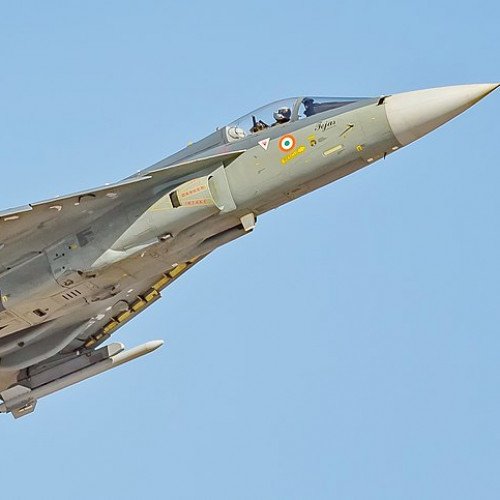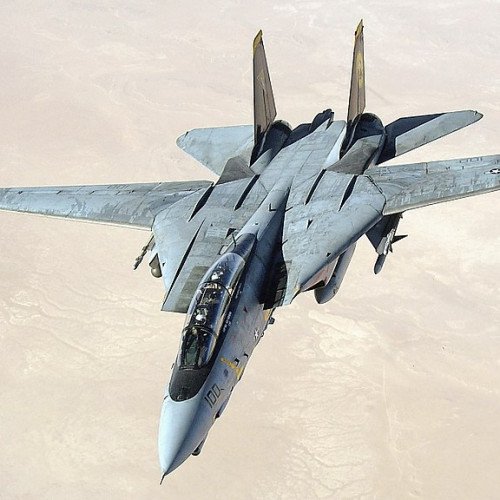HAL Tejas vs Grumman F-14 Tomcat

HAL Tejas
The HAL Tejas is an Indian single-engine, fourth-generation, multirole light fighter designed by the Aeronautical Development Agency (ADA) in collaboration with Aircraft Research and Design Centre (ARDC) of Hindustan Aeronautics Limited (HAL) for the Indian Air Force and Indian Navy. It came from the Light Combat Aircraft (LCA) programme, which began in the 1980s to replace India's ageing MiG-21 fighters. In 2003, the LCA was officially named "Tejas".Tejas has a tail-less compound delta-wing configuration with a single vertical stabilizer. This provides better high-alpha performance characteristics than conventional wing designs. Its wing root leading edge has a sweep of 50 degrees, the outer wing leading edge has a sweep of 62.5 degrees, and trailing edge has a forward sweep of four degrees. It integrates technologies such as relaxed static stability, fly-by-wire flight control system, multi-mode radar, integrated digital avionics system and composite material structures. It is the smallest and lightest in its class of contemporary supersonic combat aircraft.The Tejas is the second supersonic fighter developed by Hindustan Aeronautics Limited (HAL) after the HAL HF-24 Marut. Production of the Tejas Mark 1 for the Indian Air Force (IAF) began in 2016, at which time the naval version was undergoing flight tests for Indian Navy (IN). The projected requirement for the IAF was 200 single-seat fighters and 20 twin-seat trainers, while the IN expected to operate at least 40 single-seat fighters. The first Tejas IAF unit, No. 45 Squadron IAF Flying Daggers was formed on 1 July 2016 with two aircraft. Initially stationed at Bangalore, No. 45 Squadron was later relocated to its home base at Sulur, Tamil Nadu. The Minister of State for Defence, Subhash Bhamre, reported to parliament that the indigenous content of the Tejas was 59.7% by value and 75.5% by number of line replaceable units in 2016.As of 2019, the Indian Air Force has planned for a total of 324 Tejas in several variants. The first batch of 40 Mark 1 aircraft consists of 16 Initial Operational Clearance (IOC) standard that were delivered in early 2019. The delivery of the second batch of 16 Full Operational Clearance (FOC) standard aircraft commenced in late 2019 and led to formation of the second Tejas squadron — No. 18 Squadron IAF Flying Bullets — in Sulur on 27 May 2020. The IAF will also go on to receive eight twin-seat trainers. The next 83 are to be to the upgraded Mark 1A standard. By the time these first 123 are delivered, the Tejas Mark 2 is expected to be ready for series production by 2025–26.
Statistics for this Xoptio

Grumman F-14 Tomcat
The Grumman F-14 Tomcat is an American supersonic, twin-engine, two-seat, twin-tail, variable-sweep wing fighter aircraft. The Tomcat was developed for the United States Navy's Naval Fighter Experimental (VFX) program after the collapse of the F-111B project. The F-14 was the first of the American Teen Series fighters, which were designed incorporating air combat experience against MiG fighters during the Vietnam War. The F-14 first flew on 21 December 1970 and made its first deployment in 1974 with the U.S. Navy aboard USS Enterprise (CVN-65), replacing the McDonnell Douglas F-4 Phantom II. The F-14 served as the U.S. Navy's primary maritime air superiority fighter, fleet defense interceptor, and tactical aerial reconnaissance platform into the 2000s. The Low Altitude Navigation and Targeting Infrared for Night (LANTIRN) pod system was added in the 1990s and the Tomcat began performing precision ground-attack missions.In the 1980s, F-14s were used as land-based interceptors by the Islamic Republic of Iran Air Force during the Iran–Iraq War, where they saw combat against Iraqi warplanes. Iranian F-14s reportedly shot down at least 160 Iraqi aircraft during the war, while only 12 to 16 Tomcats were lost; at least half of these losses were due to accidents.The Tomcat was retired by U.S. Navy on 22 September 2006, having been supplanted by the Boeing F/A-18E/F Super Hornet. The F-14 remains in service with Iran's air force, having been exported to Iran under the Pahlavi regime in 1976. In November 2015, reports emerged of Iranian F-14s flying escort for Russian Tupolev Tu-95, Tu-160, and Tu-22M bombers on air strikes in Syria.